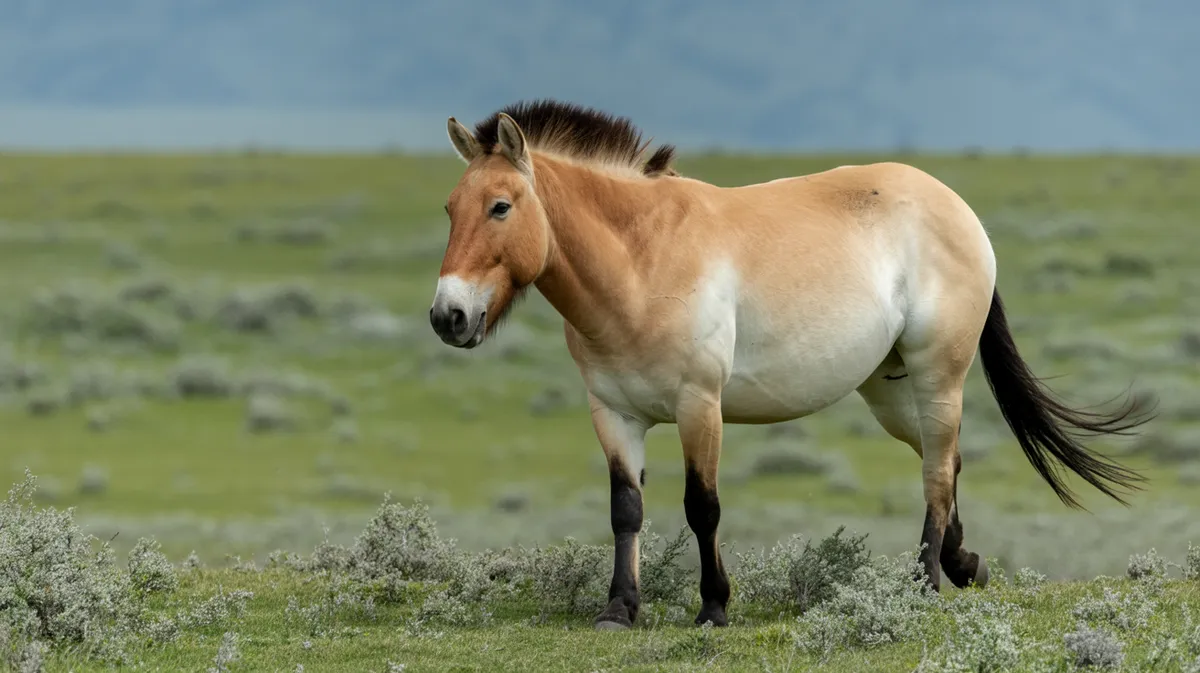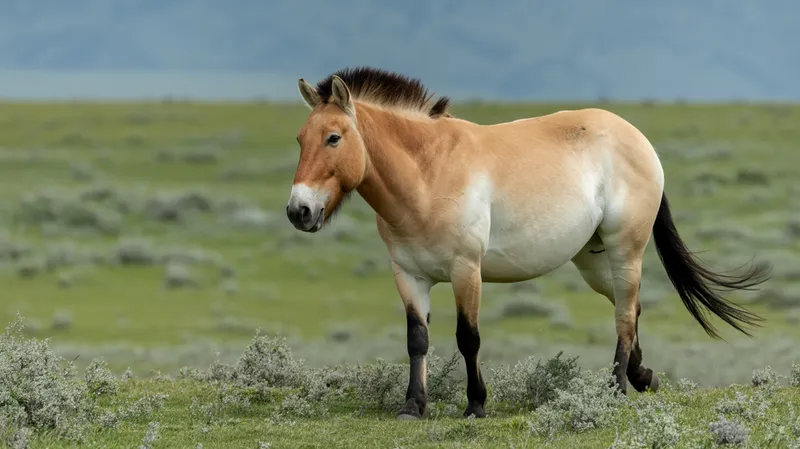
Przewalski's Horse
Equus ferus przewalskii

Meet the Przewalski's Horse
Przewalski's Horse is the last truly wild horse species on Earth, native to the steppes of Central Asia. Stocky and robust, it boasts a dun coat, erect mane, and no forelock, distinguishing it from domestic horses. Once extinct in the wild, dedicated conservation efforts have led to successful reintroductions in Mongolia and China. These social animals live in small family groups and graze on grasses and other steppe vegetation. Their survival story is a testament to the impact of global wildlife conservation projects.
Classification
Mammal
Habitat
Steppe and grassland
Diet
Herbivore
Lifespan
20-25 years
Conservation
Endangered
Weight
300-400 kg
📖Fascinating Facts
True Wild Horse
Unlike mustangs or brumbies, Przewalski's Horse has never been domesticated and is the only surviving subspecies of wild horse.
Unique Diet
These horses graze on tough steppe grasses and can survive harsh winters and dry summers by digging for roots and drinking snowmelt.
Genetic Distinction
Przewalski's Horses possess 66 chromosomes, two more than domestic horses, making them genetically distinct even though they can produce hybrid offspring.
📋Detailed Description
Przewalski's Horse (Equus ferus przewalskii) is a robust, medium-sized equid distinguished by its stocky build, short legs, and a large head with a convex profile. Adults typically stand 120–146 cm at the withers and weigh between 240–300 kg. Their coat is a distinctive dun color with a pale belly, dark lower legs, and a stiff, upright mane lacking a forelock. Seasonal coat changes occur, with a thicker, woollier winter coat providing insulation against harsh steppe climates. The species exhibits pronounced sexual dimorphism, with stallions being slightly larger and more muscular than mares. Przewalski's Horses are highly social, forming stable harem groups led by a dominant stallion, several mares, and their offspring, while bachelor groups consist of non-breeding males. Their vocalizations include neighs, snorts, and whinnies, used for communication within groups. These horses are primarily crepuscular, grazing during dawn and dusk to avoid midday heat and predators. Their digestive system is adapted for a high-fiber, low-nutrient diet, allowing efficient extraction of nutrients from coarse steppe grasses. Unlike domestic horses, Przewalski's Horses have 66 chromosomes (compared to 64), a key genetic distinction. Their survival in the wild is closely tied to their ability to traverse vast territories in search of food and water, often covering 10–20 km per day.
💡 Did you know?
Przewalski's Horse was once considered extinct in the wild and survived only in zoos for much of the 20th century.
🔬Research & Sources
Wikipedia Summary
Przewalski's horse, also called the takhi, Mongolian wild horse or Dzungarian horse, is a rare and endangered wild horse originally native to the steppes of Central Asia. It is named after the Russian geographer and explorer Nikolay Przhevalsky. Once extinct in the wild, since the 1990s it has been reintroduced to its native habitat in Mongolia in the Khustain Nuruu National Park, Takhin Tal Nature Reserve, and Khomiin Tal, as well as several other locales in Central Asia and Eastern Europe.
Last Modified: 5/22/2025
🎭Behavior & Social Structure
Przewalski's Horses are non-territorial but maintain well-defined home ranges, which can span up to 300 square kilometers. Social structure revolves around harem groups, typically comprising one dominant stallion, 3–10 mares, and their foals. Bachelor groups are common among younger or displaced males. Stallions defend their harems vigorously, using displays, vocalizations, and physical confrontations. Feeding behavior is primarily grazing, with a diet consisting of over 70 species of grasses and herbs, supplemented by shrubs and bark in winter. Water is essential, and herds will travel considerable distances to reach reliable sources. Daily routines involve alternating periods of grazing, resting, and social interaction. Mutual grooming strengthens social bonds, while dust bathing helps maintain coat health and deter parasites. Vigilance is high, with group members taking turns watching for predators such as wolves.
👶Reproduction & Life Cycle
Breeding in Przewalski's Horses is seasonal, with most conceptions occurring between April and July. Mares reach sexual maturity at 2–3 years, while stallions mature slightly later. Gestation lasts approximately 330–345 days, resulting in the birth of a single foal, usually between May and July. Foals are precocial, standing and nursing within an hour of birth. Maternal care is intensive during the first weeks, with foals gradually integrating into the group and beginning to graze at 2–3 weeks old. Weaning occurs at 8–13 months. Stallions play a protective role but do not participate in direct care. Reproductive success is influenced by social stability, resource availability, and predation pressure.
🛡️Adaptations & Survival
Przewalski's Horses are uniquely adapted to the extreme continental climate of the Central Asian steppes. Their dense winter coat provides insulation against temperatures that can drop below -40°C, while their summer coat is lighter and shorter. The species' large nasal passages help warm and humidify cold air before it reaches the lungs. Hooves are broad and tough, suited for traversing rocky or sandy terrain. Their digestive system allows them to process fibrous, low-quality forage efficiently, a necessity in nutrient-poor environments. Behavioral adaptations include crepuscular activity patterns to avoid heat and predators, and the formation of cohesive social groups for protection and efficient resource use.
📚Research Sources
🎨Cultural Significance
Przewalski's Horse holds significant cultural value in Mongolia, where it is known as 'takhi' and revered as a symbol of the nation's wild heritage and resilience. The horse features in Mongolian folklore and is associated with spiritual beliefs about the steppe's natural balance. Historically, it was sometimes hunted or captured, but today it is protected and celebrated as a conservation success. The species' rediscovery and reintroduction have inspired international cooperation and serve as a model for rewilding efforts worldwide.
🔬Recent Research & Discoveries
Recent genetic studies have clarified the evolutionary relationship between Przewalski's Horse and domestic horses, confirming that they are separate subspecies with distinct chromosomal counts. Notably, all extant Przewalski's Horses descend from just 12–15 founders, making genetic management critical. Ongoing research focuses on improving genetic diversity through managed breeding and potential gene flow from cryopreserved material. Behavioral ecology studies are examining how reintroduced populations adapt to wild conditions, including changes in social structure, foraging strategies, and predator avoidance. Conservationists are also investigating the impacts of climate change and land use on habitat suitability. Advances in GPS tracking and remote sensing are enhancing understanding of movement ecology and habitat use.
🎥Wildlife Videos

Resurrecting the Wild | The Incredible Comeback of Przewalski's Horses
Welcome to our channel! In this captivating episode, we delve into the awe-inspiring world of Przewalski's horses, the last truly ...
Bite-sized Documentaries

The Wild World of Przewalski's Horse
Enter the wild world of Przewalski's horse, the last true wild horse species. Roaming the steppes and deserts of central Asia, these ...
Exploring Animal & Nature

Przewalski Wild Horse Documentary
Animax visits horses.
Animax Corporation

Przewalski's horse: Subspecies returned to wilds after near extinction
The world's last remaining wild horses are returning to their natural habitat in central Asia. Przewalski's horse went extinct in the ...
Al Jazeera English

RIDE Documentaries: History of the Horse - Przewalski's Horse
Check out this segment from RIDE Documentaries that features our own Michael Birt talking about Przewalski's horses!
FossilRimWildlifeCenter

Wild Przewalski's Horses Roam Free in Chornobyl's Forgotten Lanscapes
I met these horses while driving from Chornobyl Nuclear Power Plant to Chornobyl town. They were standing not far from the road ...
Chornobyl WildLife
🌍Habitat Information
The Przewalski's Horse typically inhabits Steppe and grassland environments. Przewalski's Horses have adapted to their environments with specialized features and behaviors.
Primary Habitat:
Steppe and grassland
More detailed habitat information will be available soon.
🛡️Conservation Status
The Przewalski's Horse is currently classified as Endangered. Conservation efforts are crucial for preserving this species for future generations.
Common Threats:
- 🏠Habitat loss and fragmentation
- 🌡️Climate change impacts
- 🎯Hunting and poaching
- 🏭Human-wildlife conflict
⚠️Threats & Conservation Challenges
Current threats to Przewalski's Horse include habitat fragmentation, competition with livestock for grazing and water, disease transmission from domestic horses, and genetic bottlenecks due to the small founder population. Climate change poses additional risks by altering steppe vegetation and water availability. Human encroachment and infrastructure development further restrict suitable habitat. Despite successful reintroduction, wild populations remain vulnerable, with fewer than 2,000 individuals globally (as of 2023), most in Mongolia. Conservation challenges include maintaining genetic diversity, monitoring disease outbreaks, and ensuring sustainable coexistence with local pastoralists.
🔬Scientific Classification
Scientific Name
Equus ferus przewalskii
Classification Hierarchy
🔍 About Taxonomic Classification
Taxonomic classification is a hierarchical system used by scientists to classify and organize living organisms based on shared characteristics and evolutionary relationships.
The system moves from broad categories (Kingdom) to increasingly specific ones, with each animal's scientific name typically consisting of its Genus and species.
📝Community Notes
Share your observations and insights about the Przewalski's Horse with our community of wildlife enthusiasts.
Join Our Community
Sign in to share your observations and connect with fellow wildlife enthusiasts.
Sign In to ContributeNo community notes yet
Be the first to share your observations about the Przewalski's Horse!
Explore Przewalski's Horse
Select a tab above to learn more about this amazing animal.
📸Photo Gallery
No photos available for this animal yet.
🌟Discover More Wildlife
Continue your journey of discovery with more fascinating animals from our database
